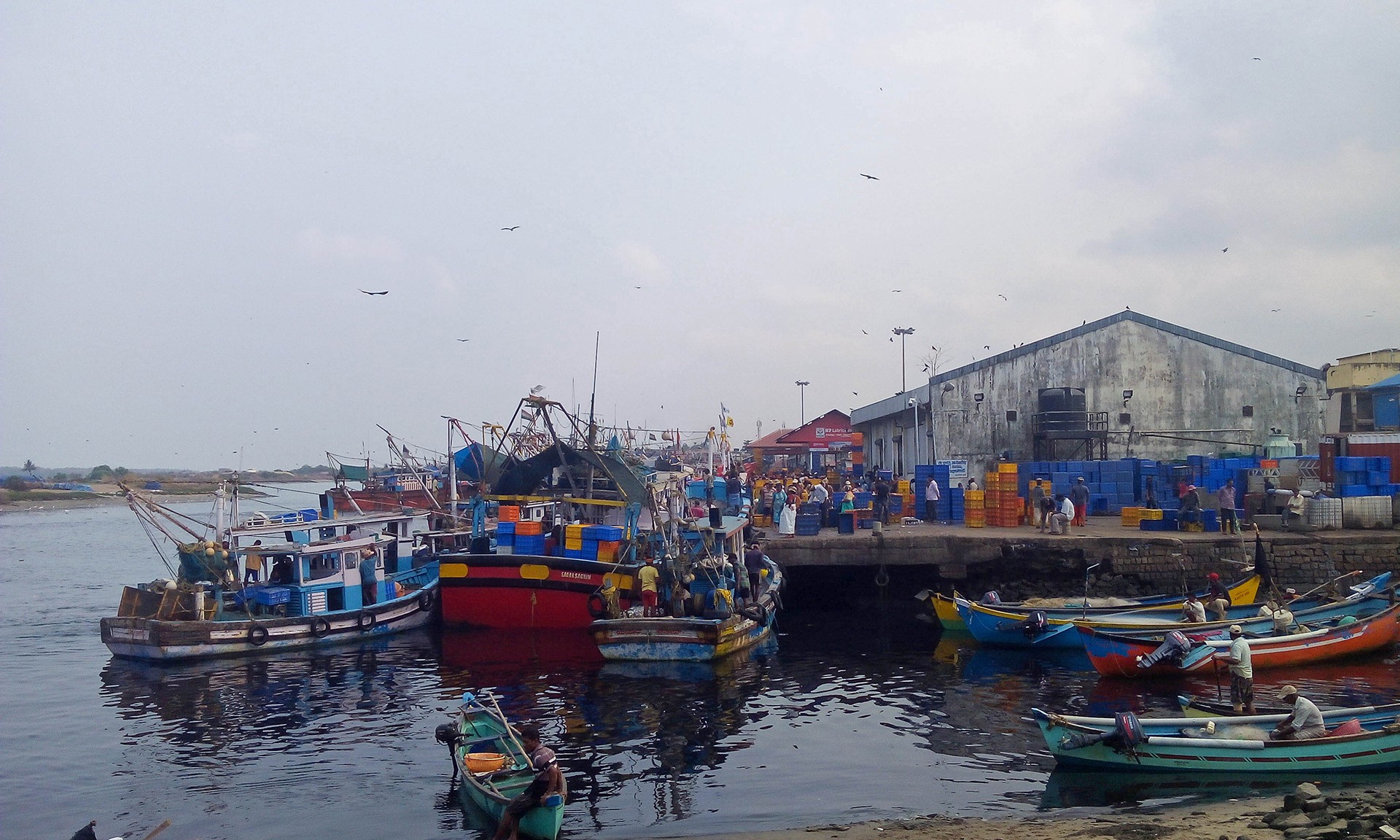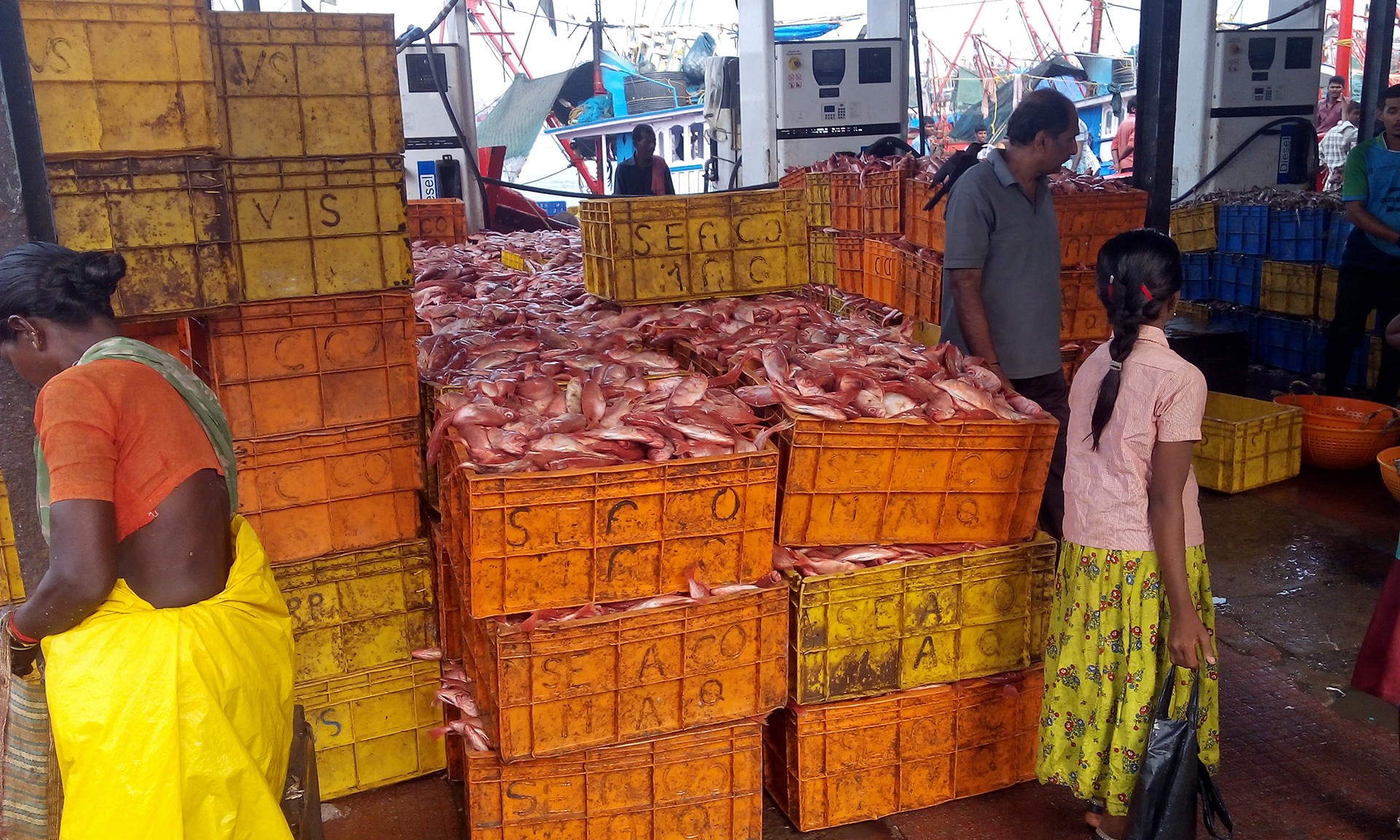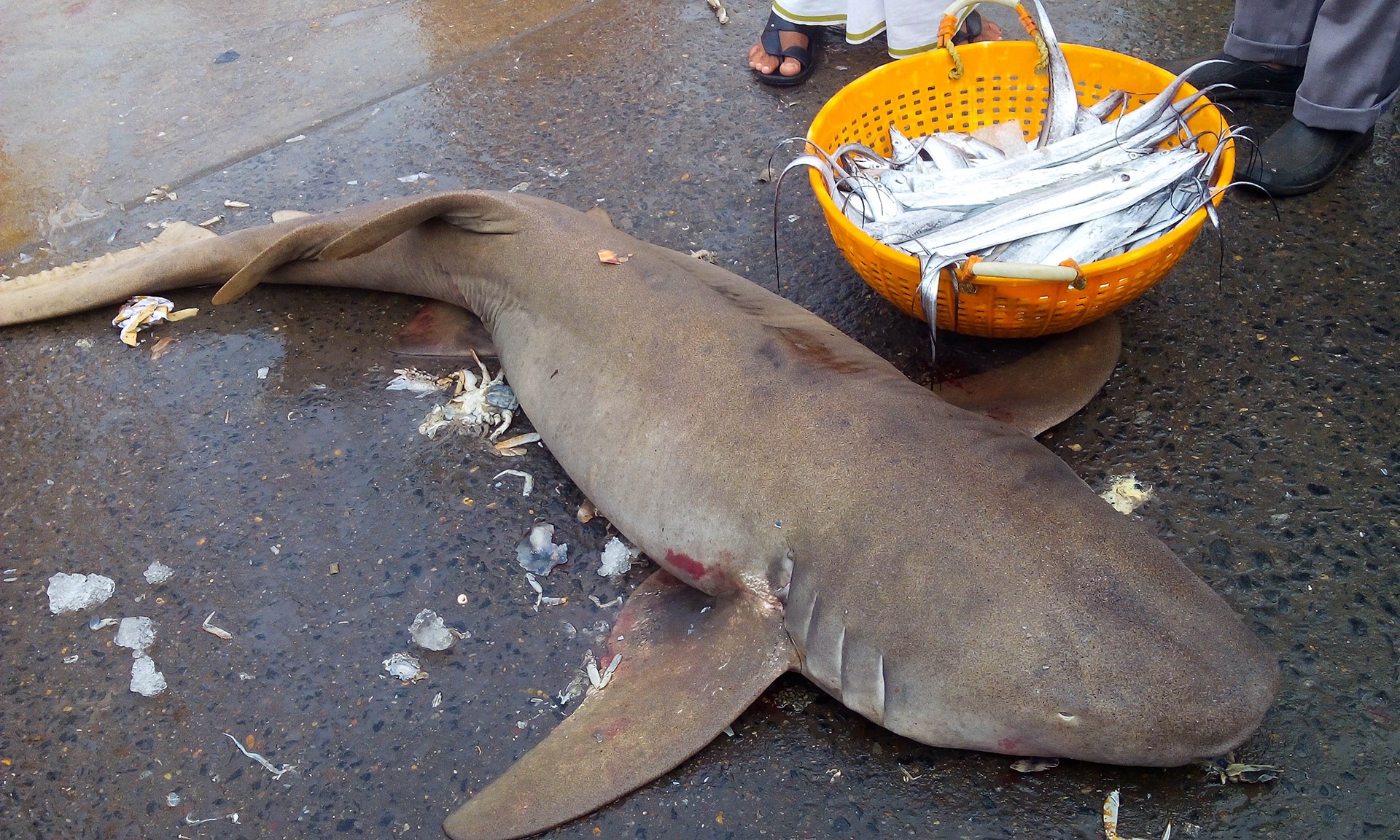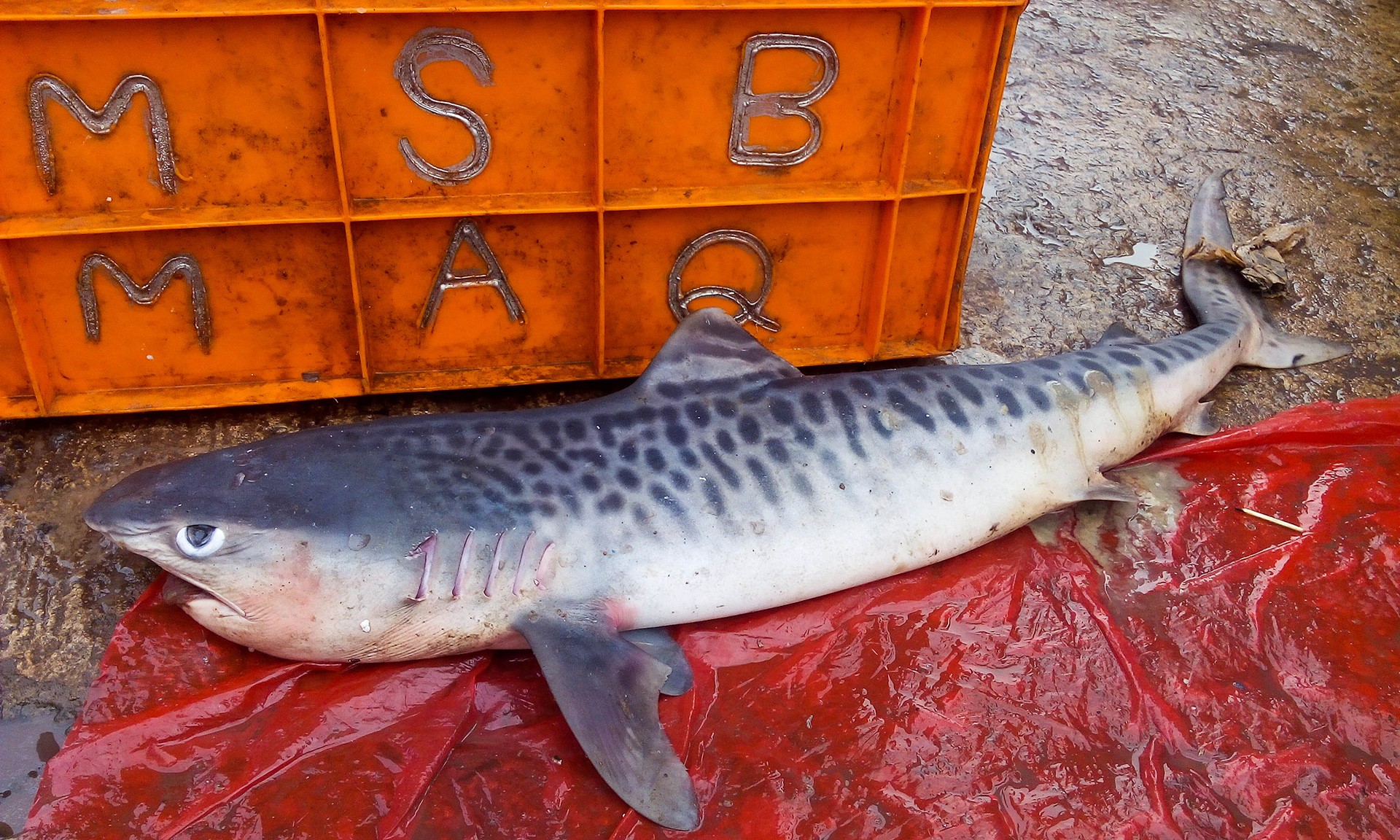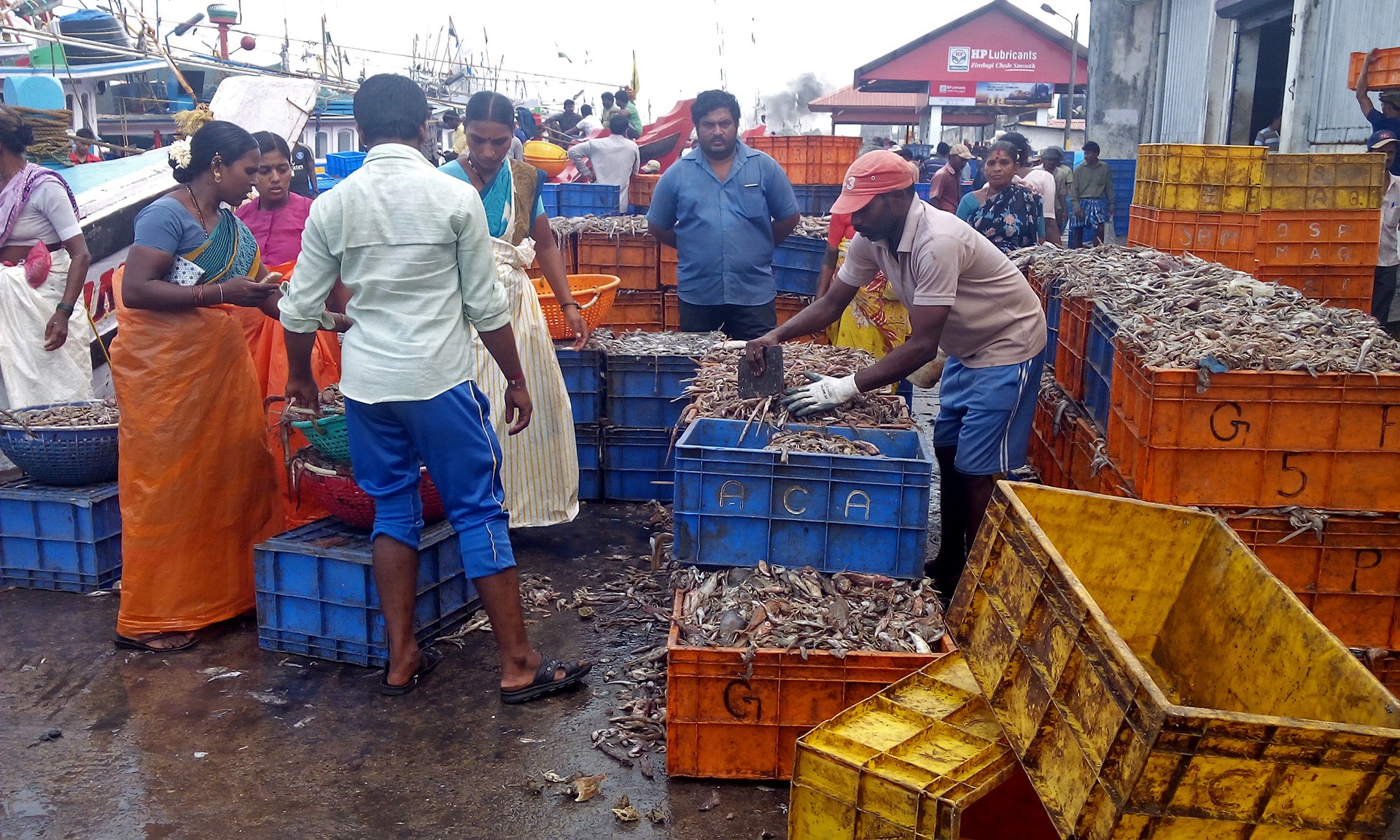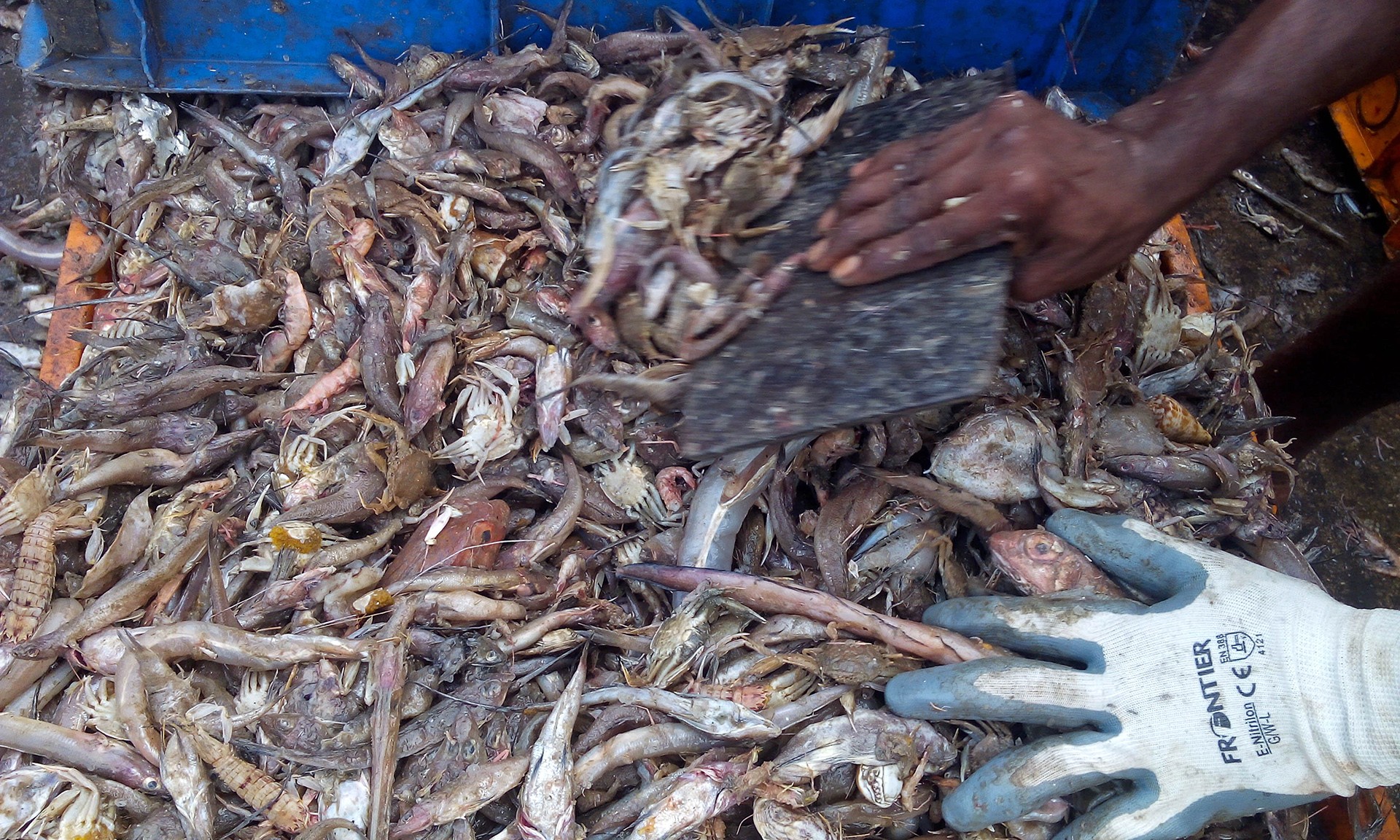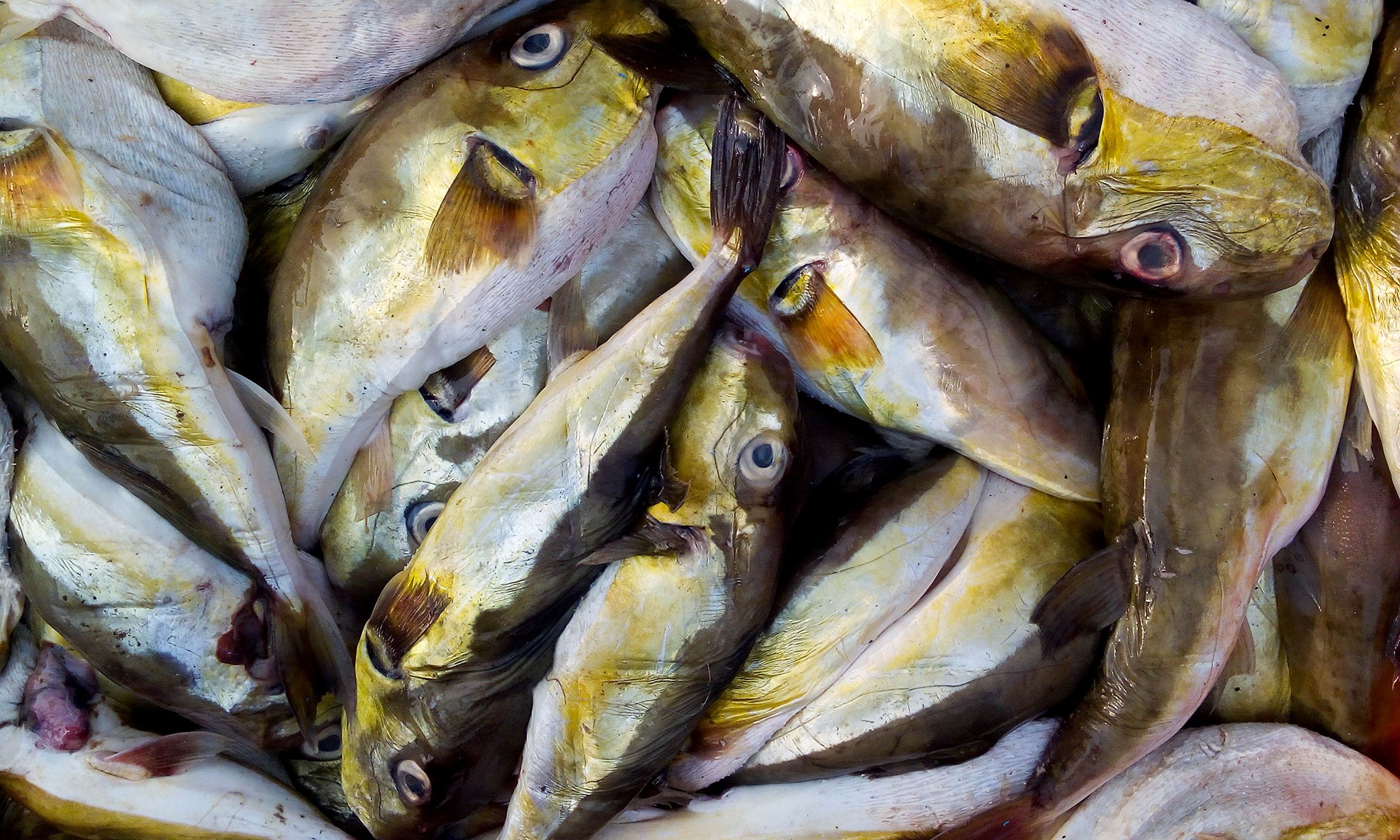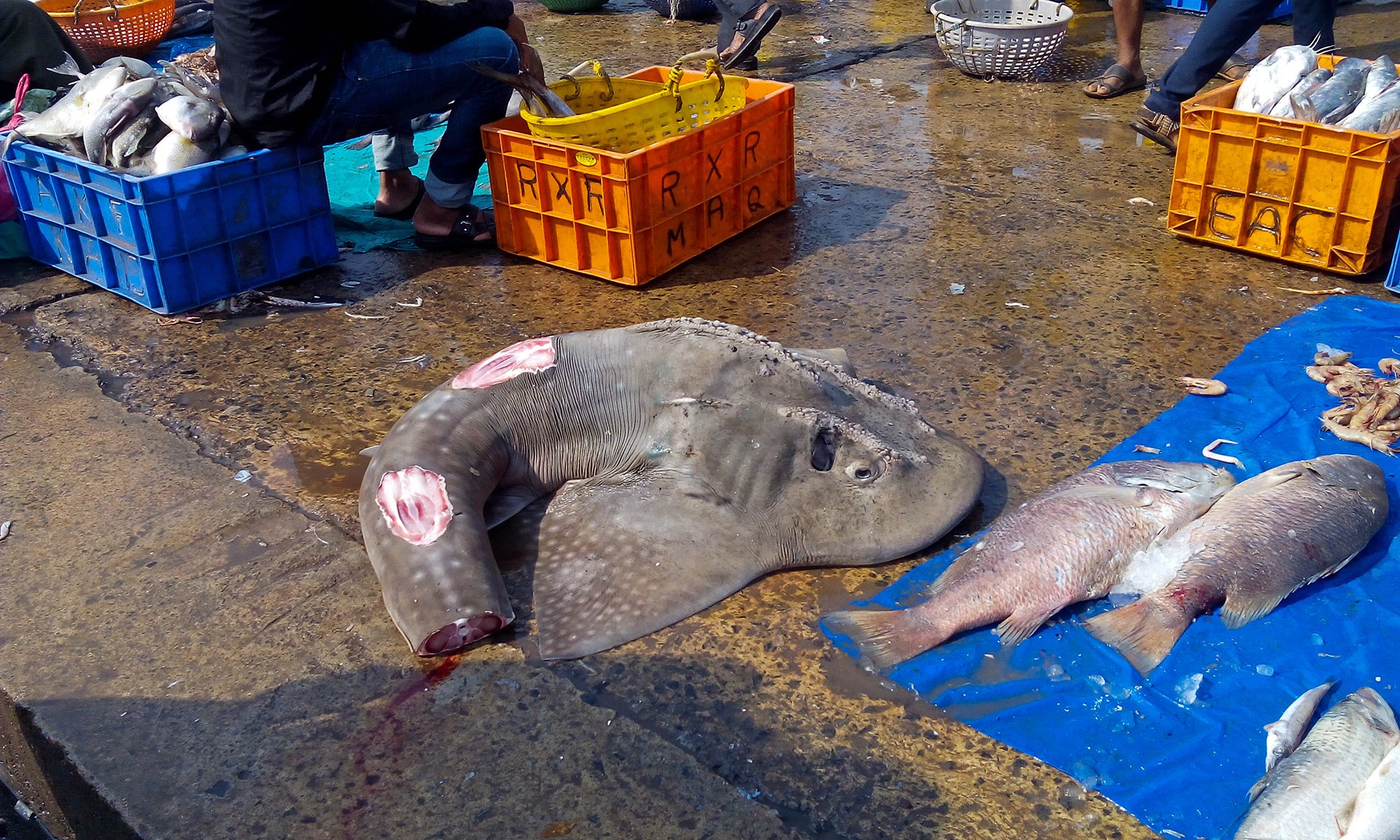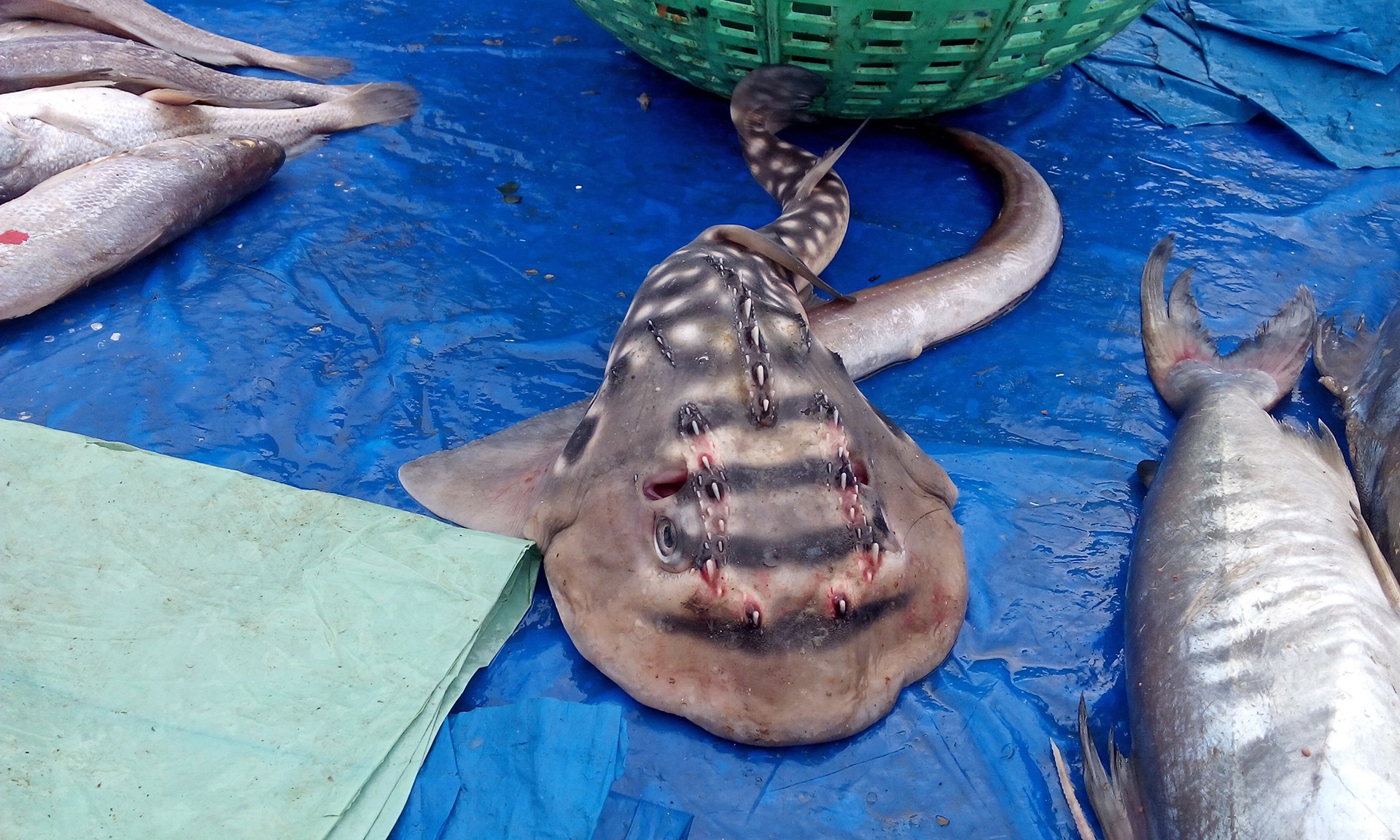You can always tell when you are close to the sea. The air gets heavier and saltier. Then there’s the whiff of dried fish, a dead giveaway to the sea (yes, pun intended). As you reach the point where land meets water, the two odours become inseparable, overpowering your senses. I find the first aroma inviting: it invokes childhood memories of beachcombing. The second arouses more curiosity and disgust. Curiosity, because I want to see the myriad creatures that emerged from the depths of the ocean, and disgust, because they are all ghostly, discoloured versions of their living glory.
I study freshwater fish and the streams they inhabit in the headwaters of river Nethravathi in the Western Ghats of Karnataka. Even though my field site is a mere 80km away from the coast, I dearly miss the sea. So when an opportunity to be close to it presented itself, I couldn’t say no. Mayuresh Gangal, a fellow researcher, a former veterinarian, and a good friend needed some help with his fieldwork.
Mayuresh has been studying marine fisheries for several years now. He knows his fish, on his plate and off it. His study involves understanding whether the boundaries within which fisheries operate coincide with those of commercially caught fish. Since fisheries are a state subject, the restrictions on where and when one can fish are determined by each state. But fish know no borders.
The distribution of fish populations may span multiple states, being affected differently by each state’s policy. To address this, Mayuresh plans to look at the genetic similarities between different fish populations across the western coast of India. For instance, if a population of species X in Kerala is genetically similar to the population in Karnataka, then it might not be okay to have different state policies to manage species X sustainably.
He intends to establish the relatedness between different fish populations by subjecting samples – small fin clips of a few species of commercially caught fish – to genetic analysis. He had been sampling in harbours all along the western coastline of India. On a scorching day in April this year, it was Mangaluru’s turn. My role was to speak with the fishermen in Kannada or Tulu, to enquire about their catch and assist Mayuresh in collecting samples.
My tryst with Mangaluru goes a long way back – I was born there. Popularly known as Kudla in Tulu, the local language, Mangaluru was once a quaint little fishing town, with pristine beaches and temples. Today, it is the largest city in the coastal and Malnad districts of Karnataka.
As we approached the fishing harbour, the stench of rotting fish became truly unbearable. The harbour looked nothing like I remembered it. What was once a small artisanal fishing port is now an industry – with different kinds of fishing vessels, from mechanised purse-seiners and gill netters to mammoth trawlers, a shipyard where ships are tended to, a massive ice factory churning out ice blocks, and a central meeting place where auctions were held for the daily catch.
Like all coastal communities, Mangalureans have an ardent love for seafood. The sea provides them with plenty – at least for now. A portion of the catch is sold for local consumption, but most of what is landed by the trawlers is meant for export. Testimony to this is the string of seafood export companies that operate from the harbour. At the landing docks surrounding the marketplace, workers, numbering in the hundreds, seem to have only one job: to empty the cargo from the docked ships, load them into crates and layer it with crushed ice, all with near-industrial efficiency.
We found our first study species very soon – Ribbon Fish, a slender, elongated, eel-like silvery fish with a menacing look. Ribbon Fish are a coastal, pelagic (occupying the mid-columns of sea), predatory species of fish. Every trawler that had docked had several tens of crates of Ribbon Fish. Between 2008 and 2012, Ribbon Fish formed 6.2 – 12.4 percent of the total trawl catch in Karnataka. It was evident to us that trawling – an indiscriminate fishing technique highly criticised by environmentalists for causing damage to the seabed – is a preferred technique of catching fish here. In fact, nearly half of Karnataka’s trawl fisheries are concentrated in the harbours of Mangaluru and Malpe, in the neighbouring district of Udupi.
Some of the workers could not hold back their curiosity and stopped in their tracks to observe us. One of them even called us “fish-doctors” when he saw us wear gloves, take samples from the fish and preserve them in alcohol filled test tubes. A man next to me was diligently taking down notes and counting the number of crates. I asked him, “Ee varsha meenu olle sigta unta?” (“How is the catch this year?”). In response, he said something profound: “We reap the benefits of something we never sow; this is why seas are unique. Sometimes she gives, sometimes she takes.”
It took a while for us to find our next target species, the Spinycheek Grouper. As its name suggests, it has prominent spines on its gills. These fish are found in depths from 10-120m, mostly on muddy or sandy bottoms in the Indian Ocean. Like other groupers, Spinycheek Groupers are predatory and they feed on crabs, prawns and other fish.
We managed to find only a few which were being locally sold by one of the vendors. I asked one of them, “Neevu meenu hidilike eshtu doora hogtiri? Grouper meenu nimage elli sikkithu?” ("How far do you go out fishing and where did you catch these groupers?”). His enthusiastic reply came with a smile: “My ship can stay in the sea for more than a week. This fish was caught close to Gujarat. We trawl at depths up to 50m.”
I was astounded to hear that these trawlers would stay in the high seas for more than a week and venture all the way up to Gujarat, more than 800 nautical miles (3.5 days by sea) away from Mangaluru.
Although each state has its own maritime boundaries within which fishing vessels should operate, these boundaries are often porous and not monitored. In a way, these ships, irrespective of which state they came from, play a game of “finders, keepers” in the open sea.
The IUCN lists the Spinycheek Grouper as “Near Threatened” and identifies overfishing by trawlers as one of the potential threats. After bumper catches in Mangaluru between 1988 and 1993, where the landing of Spinycheek Grouper increased by a whopping 328 per cent, subsequent years have seen a steep decline in their catch.
We walked around the harbour, which seemed to stretch for nearly a kilometre. It took some time to realise that some of our target species, like the wolf herring, scoliodons and other estuarine species, were missing, even though the diversity and sheer number of fish that had been landed were staggering, and caused us more than a little dismay.
Except for the usual suspects – Indian Mackerel, Indian Oil Sardines, Seer Fish and a few Silver Pomfret, most of the fish we saw were new to me. I was introduced to Puffer Fish, Red Soldier Fish, Ribbon Fish, Trigger Fish, groupers, remoras, Guitar Fish, rays and different kinds of sharks, which were all mostly landed by trawlers.
Perhaps the most appalling sight was of two Tiger Sharks on sale. Mayuresh was anguished. “These Tiger Sharks are juveniles, probably only a few days old,” he said.
Tiger Sharks are like the great white shark equivalents of the tropical seas – an apex predator. When the top predator is removed from the food chain, the prey species which occupy lower tiers of the food chain are released from the pressures of predation and increase drastically in number.
For example, in the Caribbean waters, the removal of sharks led to an increase in their prey fish, the groupers. The groupers population exploded and hunted down parrot fish, which are mostly herbivorous fish responsible for cleaning the corals by eating the algae which grows on them. Thus, the algal domination which decimated the coral reefs was potentially a cascading effect of the removal of sharks. In ecological parlance, this phenomenon where the integrity of the entire ecosystem is affected by the removal of a top predator is known as a trophic cascade.
I was still affixed by the menacing eyes of the Tiger Sharks lying motionless on the floor, when Mayuresh pointed in the direction of a large heap of shrimp, smaller fish, crabs, starfish and clams. The workers were haphazardly filling the assortment into crates. “What do you do with these?” I asked one of the men who were piling up the crates. “We turn them into fish-meal for poultry feed.”
I had observed that from every ship that had docked, the workers were offloading large amounts of low-value catch – the stack of crates kept growing taller. There were around 50 trawlers on the docks. Each trawler approximately had about 30-40 crates of low-value catch, and each crate could easily hold about 10-15 kilos. I felt a little dizzy when I scaled it up and imagined what happens day and night at the 1,511 landing centres situated along the 6,100 km-long mainland coastline of India.
In fisheries, this low-value catch is known as bycatch or accidental catch. The total landing of low-value catch in the Mangaluru harbor increased from 3000 tons in 2008 to 12,000 tons in 2011. Mayuresh suggested that this was a classic case of diminishing returns, a tell-tale sign that a common resource is being mismanaged. In order to increase fish yield, fishermen use more and more intensive techniques like trawling, overfish most of the commercially high value target fish and then increasingly catch less profitable fish in large numbers.
According to CMFRI (the Central Marine Fisheries Research Institute), the estimated marine fish landings in India in 2015 was 3.4 metric tons, compared to 0.6 metric tons in 1950 – a staggering 5.5 fold increase. India’s seafood exports for 2016-17 were also reported to be valued at an all-time high of US $5.78 billion, according to MPEDA (our Marine Products Export Development Authority).
What changed between then and now? Trawling began in the Indian seas in 1956. In the initial years since the advent of trawling, studies showed that commercial landings increased. Commercially targeted stocks such as pomfret and mackerel were rapidly overfished due to the highly efficient nature of trawl fishery. With a reduction in high value targets, the Indian fishery is now witnessing an increased landing of low-value catch – a process termed as fishing down the food web. For example, more than 75 percent of trawling catch which targets shrimps and prawns is made up of bycatch.
Increasingly, bycatch is extensively commercialised and trawlers are encouraged to opt for low-value targets driven by a surge in demand. Most of the low-value catch that would be discarded earlier is now landed in large quantities. This increased landing of bycatch is a major concern because a large proportion of the catch contains juveniles of commercially important fish.
The bycatch composition at the Mangaluru harbour revealed that the bycatch landing contained a total 205 species including crabs, bivalves and lobsters; a shocking 63 percent of the bycatch consisted of juveniles. Such large-scale exploitation of juvenile fish has severe effects on the population structure and their recovery, eventually hampering the sustainability of fisheries. Furthermore, since trawling involves dragging a net with a small mesh-size, it causes extensive damage to the ocean floor and its biodiversity.
Various states have regulated their own marine fishing regulation acts under the Indian fisheries act, 1897. The Karnataka Marine Fisheries Regulation Act, 1986 regulates fisheries through licensing, restrictions on number of vessels, fishing in certain areas and on fishing gear. In Karnataka, the first 6km of the sea is reserved for traditional fishing, while mechanised fishing is allowed only beyond the 6km boundary. Karnataka also imposes a monsoon ban on fishing from mid-June to mid-August to facilitate breeding and population recovery.
But most of these restrictions are not strictly enforced, and violations are commonplace. Conflicts between artisanal and mechanised fishermen are also not unheard of. The effectiveness of the closed season is questionable, as it is based on the assumption that most fish breed during the monsoon. However, many commercially targeted fish have multiple breeding seasons and breed outside the monsoon period too. While some species of fish breed for as long as six months, fish of the same species but in different localities breed at different times of the year.
What we saw in Mangaluru’s fishing harbour was a mere glimpse of a socially accepted form of hunting – one that has been mismanaged so gravely that it is now threatening to empty our seas.
At this rate, global fisheries are predicted to completely collapse by the year 2050. This has serious implications not just for marine biodiversity but also for the millions who depend on fish as an easy source of affordable protein. The over-exploitation of our seas also gravely threatens all the fisheries-based livelihoods – more so for artisanal fishermen for whom healthy fish stocks and a decent standard of living amount to the same thing. Incredibly, this is something the average Indian seafood consumer is completely oblivious to.
Mayuresh saw the dejected look on my face and pointed out that because fisheries and the livelihoods associated with it are an integral part of our culture; to ask the fishing industry to follow sustainable practices of fishing would require major upheavals. “However, the consumers of seafood can bring about a change if they choose their fish wisely,” he said. He believes that if there is reduced demand for fish associated with large bycatch, such as prawns, and if fish are spared during their breeding season (and when they are juveniles), the fisheries could certainly become more sustainable.
That line of thinking led Mayuresh and his team to recently release a calendar called Know Your Fish, which offers monthly recommendations of fish to eat and avoid. Already, some 20-odd restaurant owners in Mumbai and Goa are using it to plan seasonal menus that are kinder to the sea.
Around mid-noon, with the sun bearing down upon us, we called it a day. I suggested to Mayuresh that it was time to cheer ourselves up. Sitting in a slightly dingy restaurant a couple of kilometers away from the port, we put our weary legs to rest. We probably smelled rank, fresh from the docks – so much so that nobody seemed to want to occupy the tables surrounding us. I wanted to relish something that Mangaluru has made its own – ghee roast, a coastal gastronomic delight. (If you think this is a kind of dosa, then you need to visit Mangaluru. This ghee roast is usually prepared with prawns or chicken or eggs.)
I looked up, and noticed that Mayuresh was looking at the seafood menu and his calendar at the same time.
